Doreen Wang, global head of BrandZ Millward Brown, on the lessons of China’s “glocalized” brands
If you think ‘Made in China’ is always associated with cheap and low quality goods, think again. DJI—the first choice for any drone fan—is headquartered in Shenzhen and it dominates 70% of consumer drone market globally; Huawei, the telecommunication company that developed its first branded smartphone only five years ago, has already become the third largest player in the sector with a 9.4% market share worldwide, behind Samsung and Apple; and Youzu and Elex are both young Chinese gaming companies that continue to gain more fans and have received a decent return from foreign markets. Unlike the previous generation, who have a negative perception of Chinese brands, new consumers love affordable cool stuff, regardless of its place of origin. In this interview with CKGSB Knowledge, Doreen Wang, global head of BrandZ Millward Brown and author of the BrandZ Top 30 Chinese Global Brand Builders report published by the PR company WPP, makes sense of China’s “glocalized” brands and the bumpy roads they may face in future.
There is a changing attitude towards ‘Made in China’—it is not a reflection of ‘cheap and non-durable’ anymore, and we do see some brands like Xiaomi and Huawei doing well. What are the biggest challenges Chinese companies are facing in foreign markets at the moment?
In established markets, consumers’ mindsets are gradually changing, and this is especially true among young consumers. A good example is young consumers in Spain—because of the economic challenges that they are facing, they don’t mind waiting for 15 days to get some cool products delivered from China. This is not just young consumers who know Chinese brands, but also young people who don’t have much money, so they want cool products at a more affordable price. That’s a very important trend we are seeing in lots of European countries. This has been facilitated by Chinese global e-commerce platforms such as Alibaba and JD.com.
Challenge number one is the very low awareness of Chinese brands—they are still selling products, but they are not selling the brand. Only branded products bring better margins; if they keep selling products, there’s always [a risk of] “me too”. It could be a “me too” from Indonesia, from Israel. The brand building process is way longer than just having the product sitting on the shelf or having your product on an online channel.
Challenge number two is the perception of low quality; it is still there. Young consumers are open and think Chinese brands are very innovative, however they still question the quality. We have well-known brands like Huawei and Xiaomi, but there’s only a handful of them. Segway is good, but nobody knows Segway belongs to Ninebot, so when consumers buy Ninebot they will wonder if Ninebot is durable and safe… so quality concern still exist, and it takes time for Chinese brands to change this.
And the third challenge for Chinese brands is: We want to go global, but at first we only want to test the water, we don’t want to invest. “Let’s try this and see if I can win, and if not I can withdraw easily because I didn’t invest too much.” That strategy does not work when you are going global.
Why? Because you need commitment when going into any market. Think about it, 30–40 years ago when Coca-Cola or Pepsi came into China, they did in-depth consumer research, consumer insight understanding, why consumers needed the product and how they could serve the product to locals. When Chinese brands go global, do they understand the conditions and consumers’ needs? Not really.
In established markets, normally you have to sell in a niche. To sell to a niche, you need about niche needs, but if you do not understand consumer’s needs how can you find a niche market? A lack of investment means I do not have that commitment.
Ninebot and DJI have local marketing and sales, and even some local R&D, which is really good, because in that way you build a global brand and can really leverage local talents and the local sales force.
So one of the factors that made DJI successful was allocating decision-making rights to its branches?
Yes, you have to give the local operations flexibility and decision-making power, otherwise they won’t be able to quickly adapt to the local market.
How did Huawei become so successful?
Let me give you an interesting example. When I was in Salvador, a Latin American country, in the airport I noticed that Huawei’s advertisement is everywhere. Huawei has invested so much in Latin America, in Europe, in Middle Eastern countries—it has invested in advertising heavily to build their brand globally. Huawei has a great product, but it also understands that the product won’t automatically sell in global market, so it is investing.
The second factor is that Huawei has a really focused strategy. For example, this year is mainly about the Mate 9—you can see they are very focused on one product and are highlighting all the great functions of that product and their very customized service. Interestingly, in Peru and Mexico I saw Huawei booths at the airport and on a busy street, and the sales person was introducing the Mate 9 to me, so that’s an example of Huawei strategically focused on one product.
The third reason is that Huawei is not limited to a certain product. If you go on Huawei’s European or US website, the landing page says Huawei’s purpose: “Building a better connected world”. That’s Huawei’s purpose, its brand ideal. But a lot of Chinese companies have no brand purpose—their goal is to increase sales by 25% next year.
Accordingly to the BrandZ Top 30 Chinese Global Brands Builders report, the next five to 10 years will be the best time for Chinese brands to go global. Why?
Brand building won’t happen overnight. Even DJI—they were really fast in terms of globalization, but still it took them the past five to 10 years to build their initial presence. Brand building needs time, and that is a mindset change, you need to change the consumer’s perception.
The second thing is, you are facing increasing competition. Not just against established brands, like IBM, Amazon and Google, but you are also facing increasing competition from Israel, from India—they are also becoming innovation hubs. So you have to capture the opportunity. Young consumers are more open, but not just more open to you, they are open to any brands, and if you want to gain their preference faster then you have to do better than the other brands.
Marketing remains a key step for a brand to become notable. Can you share a couple of examples of successful marketing cases by different Chinese brands?
Oppo and Vivo are sponsoring events and programs a lot, and that’s the right thing for them to do to really gain momentum and increase familiarity, especially among young consumers. In our recent finding “Which Chinese brands are winning among young consumers?”, Oppo is number one.
Cheetah and Elex are doing well in foreign markets, but not so good domestically. That’s also a good strategy—I have global DNA and I want to build a strong brand abroad, then come back to China. 10 years ago, if you asked me I would say you have to be strong in your home market before going global, because all the global brands are built up that way, but in the past 10 years, because of digitalization, globalization is not the same as before and now you can be born global and have global DNA from day one.
Many Chinese brands are making acquisitions abroad: Haier bought GE’s home appliances division, Ninebot merged with Segway and Tencent bought Supercell. Is it a shortcut for Chinese brands to be recognizable in foreign markets?
When Haier acquired GE Appliances, there was some PR in the US and in Europe, but it wasn’t very aggressive PR. [The acquisition doesn’t help much with brand recognition], but helps Haier portfolio development. A similar example is Tencent’s investment in Telsa and its acquisition of Supercell—that’s Tencent’s move from being an online platform to a manufacturer. In terms of Ninebot acquiring Segway, Ninebot wants to own the technology of short-distance-transportation around the world, so anything to do with short distance transportation [will be of interest]. So different brands have different purposes, it’s not just for brand recognition.
India is developing at a fast pace, and tech companies from the US, China and Europe are all rushing into this new battle ground. How can Chinese brands win? Also to a broader extend, how should Chinese brands be setting goals and targets in different markets?
India is absolutely an interesting market—it’s the third-largest startup nation, and I’m very impressed by Indian startups. India has all these counterpart products developed by their local market in place of global internet platforms. So FlipKart or Snapdeal is Alibaba, Ola is Didi, Paytm is Paypal. Anything you have globally or in China, India has its own version. I think in the internet in India is more like China; they are building their own ecosystems with their local brands.
So for Chinese brands to win in India, they are not just facing Amazon or Facebook, they are also facing local competition. Local competition is actually the fiercest competition.
So I think to win the market there, there are three things Chinese brands should do. The first is to ensure that the product is meaningful to the local consumers—you can’t just assume that, for example, if India doesn’t have e-commerce, then I can come in and I will win, no. In India [a lot of things] are already fast, they have really smart technology and very talented people, so you won’t be able to set up something like what you can in a market like Brazil.
Second, you need a real technological advantage over local brands, which is very hard, and in terms of a real technological advantage by Chinese brands over the local brands, I do not see anything major.
And third, Indian brands are very willing to invest in marketing and communication. When you go to the UK, you turn on the TV and see 10 advertisements, maybe one or two are brands from India, and probably none are from China.
The willingness to spend on marketing, is that something to do with Indian culture or do they just have the awareness to spend in the right places?
I go to India every year to launch BrandZ Top 50 Most Valuable Indian Brands report and we always organize a top 20 brands CEO panel. When I listen and talk to them, I realize that their strategic thinking is way in advance compared to Chinese business leaders’ strategic thinking. Chinese are very good at expansion, they are very business sales oriented, but I have to admit a lot of them do not have an international or global mindset or global strategic thinking. Their mindset is “I need to make money tomorrow and in the next five years”. And actually I am a bit excited to see if some second-generation leaders can take over a big business, because a lot of them really have a global perspective and experience. They can probably bring the business up to the next level even better than their predecessors.
Back to the Indian CEOs, a lot of them are also entrepreneurs and a lot of them have received education in the West and they understand brand building—they have a great story to tell the consumers. Plus, they are not shy on technology and their technological innovation is very strong. So all these things together make them a very strong competitor.




















